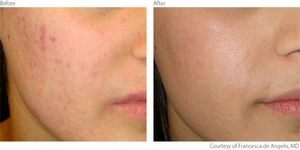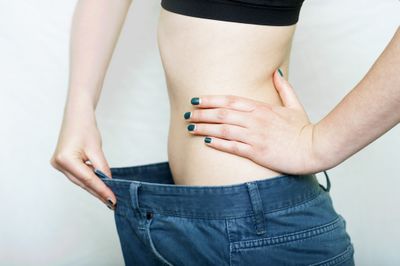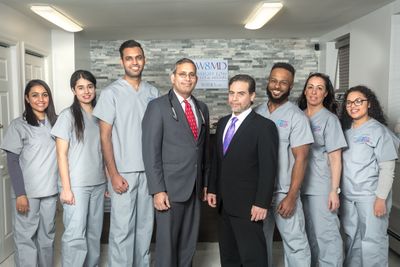Scar

Editor-In-Chief: Prab R Tumpati, MD
Obesity, Sleep & Internal medicine
Founder, WikiMD Wellnesspedia &
W8MD medical weight loss NYC and sleep center NYC
| Scar | |
|---|---|

| |
| Synonyms | Cicatrix |
| Pronounce | N/A |
| Specialty | N/A |
| Symptoms | Fibrous tissue formation, discoloration, thickening of the skin |
| Complications | Keloid, hypertrophic scar, contracture |
| Onset | After injury, surgery, or inflammation |
| Duration | Permanent, may fade over time |
| Types | N/A |
| Causes | Wound healing process |
| Risks | Infection, repeated trauma, genetic predisposition |
| Diagnosis | Physical examination |
| Differential diagnosis | Keloid, hypertrophic scar, dermatofibroma |
| Prevention | Proper wound care, silicone gel sheets, pressure therapy |
| Treatment | Laser therapy, steroid injections, surgical revision |
| Medication | N/A |
| Prognosis | Generally good, but varies with scar type |
| Frequency | Common |
| Deaths | N/A |
A scar tissue is a result of injury, which can be due to accidents, surgery, acne. Scar tissue is usually discolored or differently colored and textured compared to the surrounding skin. There are many ways to manage a scar in Aesthetic medicine and Plastic surgery.

There are several ways to improve the appearance of scars:
- The scar may be removed completely and the new wound closed very carefully.
- Dermabrasion involves removing the upper layers of the skin with a special wire brush called a burr or fraise. New skin grows over this area. Dermabrasion can be used to soften the surface of the skin or reduce irregularities.
- A cosmetic laser may be used to soften the surface of the scar, and stimulate new collagen growth within the scar.
- Very large injuries (such as burns) can cause loss of a large area of skin and may form hypertrophic scars. These types of scars can restrict movement of muscles, joints and tendons (contracture). Surgery removes extra scar tissue. It may involve a series of small cuts (incisions) on both sides of the scar site, which create V-shaped skin flaps (Z-plasty). The result is a thin, less noticeable scar, because a Z-plasty may re-orient the scar so that it more closely follows the natural skin folds and releases tightness in the scar.
- Skin grafting involves taking a thin layer of skin from another part of the body and placing it over the injured area. Skin flap surgery involves moving an entire, full thickness of skin, fat, nerves, blood vessels, and muscle from a healthy part of the body to the injured site. These techniques are used when a large amount of skin has been lost in the original injury, when a thin scar will not heal, and when the main concern is improved function rather than improved appearance.
- Tissue expansion is used for breast reconstruction. It is also used for skin that has been damaged due to birth defects and injuries. A silicone balloon is inserted beneath the skin and gradually filled with salt water. This stretches the skin, which grows over time.

Laser scar revision[edit]
Laser scar revision is an effective method for treating a wide range of scars that improves skin texture and pigment as well as functional aspects. For acne and some surgical scars (see also Acne Scars Treatment), fractional skin resurfacing can effectively treat textural and pigment concerns. Intense Pulse Light or IPL can also be used to decrease pigmentation and vascular effects. Scars caused by burns and other traumatic injuries are more complicated in nature and can negatively affect the quality of life due to disfigurement, pain, bleeding, pruritis (itching) and restricted range of motion. Fractional laser resurfacing has been proven to effectively treat such scars and provide consistent and significant functional improvement as well as measurable cosmetic benefits.
Acne scar treatment[edit]
Persistent and untreated inflammatory acne lesions may cause various degrees of permanent scarring. Laser resurfacing is one of the most effective ways of reducing and clearing acne scars. Available laser treatments include ablative and non-ablative skin resurfacing. The choice of treatment depends on the type of scar (box, rolling, or icepick) and on the patient’s preferences and expectations in terms of number of treatments and downtime.
- Ablative resurfacing: ideal for patients seeking an amazing improvement in a single session.
- Non-ablative resurfacing: ideal for patients who prefer a milder treatment approach that requires several treatments but has less downtime.
Laser resurfacing[edit]
Laser resurfacing is a laser surgery technique that disassociates molecular bonds. It is used for the treatment of wrinkles, solar lentigenes, sun damage, scarring (acne scars and surgical scars), stretch marks, actinic keratosis, and telangiectasias. It can be combined with liposuction to help tighten and smooth over the new contours after removal of excess fat. Resurfacing can be ablative, which vaporizes tissue and creates wounds, or non-ablative which keeps the skin intact. When compared to a chemical peel, dermabrasion or other forms of treatment, a laser allows the surgeon to customize the surgery not only for each patient but also to each area of the face. Laser resurfacing is usually done with a 2940 nm Er:YAG laser or a 10,600 nm CO2 laser. Complete resurfacing was first done with a CO2 laser. Both Erbium and CO2 are used to treat deep rhytides, sun damage and age spots. Through the heating of the deep dermis, fibroblasts are stimulated to form new collagen and elastin helping to bring increased turgor and thickness to the skin. A variety of modes have been developed including Nd:Yag lasers and a plasma device.
Fractional laser[edit]
Fractional Laser photothermolysis (FP) is a form of laser based skin resurfacing commonly used now, with several devices on the market. A fractional laser delivers tiny pinpoints of laser light to a part of the skin. Hundreds or thousands of laser pinpoints may be used per square inch, leaving healthy skin between the ablated areas, to allow more rapid healing and lower risks. FP may provide similar results to CO2 laser resurfacing without risk of scarring or significant downtime. Complications observed in a study of 961 treatments included acne and herpes outbreaks and were temporary.
W8MD's Scar Revision Laser[edit]
Using the advanced, non-ablative skin resurfacing called ResurFX technology, W8MD weight loss, sleep and medspa offers scar treatment for both acne and other scars.
Tired of Being Overweight?[edit]
Achieve lasting results with W8MD's proven weight loss program, trusted by thousands since 2011. Our comprehensive approach tackles weight gain factors like insulin resistance to help you lose weight and keep it off.

Tailored Weight Loss Solutions[edit]
W8MD offers personalized weight loss plans, including FDA-approved medications and GLP-1 injections, such as:
Other options include:
We also offer nutritious, low-glycemic foods and meal replacements to keep you on track.
Convenient Locations[edit]
W8MD provides weight loss services in Brooklyn, New York and Greater Philadelphia, with tailored plans and GLP-1 weight loss injections.
Looking for a weight loss clinic in Brooklyn or weight loss doctors in NYC? W8MD's expert team is here to help.

Weight Loss Doctor in NYC[edit]
Trust W8MD's best weight loss doctors in NYC for personalized solutions, including wiki Physician Weight Loss Program and GLP-1 injections.
W8MD Weight Loss Clinic in Philadelphia[edit]
W8MD in Philadelphia offers FDA-approved medications and weight loss injections. Visit our medical weight loss clinic for expert care.
Find the best weight loss tips in Philadelphia with W8MD.
Take the First Step[edit]
Book your consultation today and start your journey:
- Visit W8MD Official Site
- Check out Yelp reviews
- Schedule via Patient Fusion
Call now for medical weight loss:
- NYC: 718-946-5500
- Philadelphia: 215-676-2334
Explore W8MD's NYC Physician Weight Loss Program now!
- Individual results may vary!
Ad. Transform your life with W8MD's Budget GLP-1 injections from $75


W8MD offers a medical weight loss program to lose weight in Philadelphia. Our physician-supervised medical weight loss provides:
- Weight loss injections in NYC (generic and brand names):
- Zepbound / Mounjaro, Wegovy / Ozempic, Saxenda
- Most insurances accepted or discounted self-pay rates. We will obtain insurance prior authorizations if needed.
- Generic GLP1 weight loss injections from $75 for the starting dose.
- Also offer prescription weight loss medications including Phentermine, Qsymia, Diethylpropion, Contrave etc.
NYC weight loss doctor appointmentsNYC weight loss doctor appointments
Start your NYC weight loss journey today at our NYC medical weight loss and Philadelphia medical weight loss clinics.
- Call 718-946-5500 to lose weight in NYC or for medical weight loss in Philadelphia 215-676-2334.
- Tags:NYC medical weight loss, Philadelphia lose weight Zepbound NYC, Budget GLP1 weight loss injections, Wegovy Philadelphia, Wegovy NYC, Philadelphia medical weight loss, Brookly weight loss and Wegovy NYC
|
WikiMD's Wellness Encyclopedia |
| Let Food Be Thy Medicine Medicine Thy Food - Hippocrates |
Medical Disclaimer: WikiMD is not a substitute for professional medical advice. The information on WikiMD is provided as an information resource only, may be incorrect, outdated or misleading, and is not to be used or relied on for any diagnostic or treatment purposes. Please consult your health care provider before making any healthcare decisions or for guidance about a specific medical condition. WikiMD expressly disclaims responsibility, and shall have no liability, for any damages, loss, injury, or liability whatsoever suffered as a result of your reliance on the information contained in this site. By visiting this site you agree to the foregoing terms and conditions, which may from time to time be changed or supplemented by WikiMD. If you do not agree to the foregoing terms and conditions, you should not enter or use this site. See full disclaimer.
Credits:Most images are courtesy of Wikimedia commons, and templates, categories Wikipedia, licensed under CC BY SA or similar.
Translate this page: - East Asian
中文,
日本,
한국어,
South Asian
हिन्दी,
தமிழ்,
తెలుగు,
Urdu,
ಕನ್ನಡ,
Southeast Asian
Indonesian,
Vietnamese,
Thai,
မြန်မာဘာသာ,
বাংলা
European
español,
Deutsch,
français,
Greek,
português do Brasil,
polski,
română,
русский,
Nederlands,
norsk,
svenska,
suomi,
Italian
Middle Eastern & African
عربى,
Turkish,
Persian,
Hebrew,
Afrikaans,
isiZulu,
Kiswahili,
Other
Bulgarian,
Hungarian,
Czech,
Swedish,
മലയാളം,
मराठी,
ਪੰਜਾਬੀ,
ગુજરાતી,
Portuguese,
Ukrainian